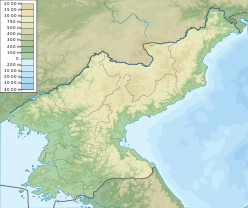Baekdu-san
| Mount Paektu | |
|---|---|

A train travelling up Paektu
|
|
| Highest point | |
| Elevation | 2,744 m (9,003 ft) |
| Prominence | 2,593 m (8,507 ft) |
| Listing |
Country high point Ultra |
| Coordinates | 42°00′20″N 128°03′19″E / 42.00556°N 128.05528°ECoordinates: 42°00′20″N 128°03′19″E / 42.00556°N 128.05528°E |
| Geography | |
| Location |
Ryanggang, North Korea Jilin, China |
| Geology | |
| Mountain type | Stratovolcano |
| Last eruption | 1903 |
| Paektu Mountain | |||||||||
| Chinese name | |||||||||
|---|---|---|---|---|---|---|---|---|---|
| Simplified Chinese | |||||||||
| Traditional Chinese | |||||||||
| Literal meaning | Ever-white Mountain | ||||||||
|
|||||||||
| Korean name | |||||||||
| Hangul | |||||||||
| Hanja | |||||||||
| Literal meaning | Whitehead Mountain | ||||||||
|
|||||||||
| Manchu name | |||||||||
| Manchu script | ᡤᠣᠯᠮᡳᠨ ᡧᠠᠩᡤᡳᠶᠶᠠᠨ ᠠᠯᡳᠨ | ||||||||
| Romanization | Golmin Šanggiyan Alin | ||||||||
Mount Paektu or Mount Baekdu (Korean pronunciation: [pɛ̝k̚t͈usʰa̠ɲ]), also known as Golmin Šanggiyan Alin in Manchu and Changbai Mountain in Chinese, is an active volcano on the China–North Korea border. At 2,744 m (9,003 ft), it is the highest mountain of the Changbai and Baekdudaegan ranges. North and South Koreans consider the volcano and its caldera lake to be their countries' spiritual home.
It is also the highest mountain on the Korean Peninsula and in Northeast China. A large crater lake, called Heaven Lake, is in the caldera atop the mountain. The caldera was formed by the VEI 7 "Millennium" or "Tianchi" eruption of 946, which erupted about 100–120 km3 (24–29 cu mi) of tephra. This was one of the largest and most violent eruptions in the last 5,000 years (alongside the Minoan eruption, the Hatepe eruption of Lake Taupo in around AD 180 and the 1815 eruption of Tambora).
The modern Korean name of the mountain, Paektu Mountain, was first recorded in the 13th historical record Goryeosa. It means white-head mountain. In other records from the same period, the mountain was also called Taebaek Mountain, which means great-white mountain. The modern name of the mountain in Chinese, Changbai Mountain, come from modern Manchu name of the mountain, which is Golmin Šanggiyan Alin or Long/Ever White Mountain. Similarly, its Mongolian name is Ondor Tsagaan Aula, the Lofty White Mountain. In English, various authors have used non-standard transliterations.
...
Wikipedia

